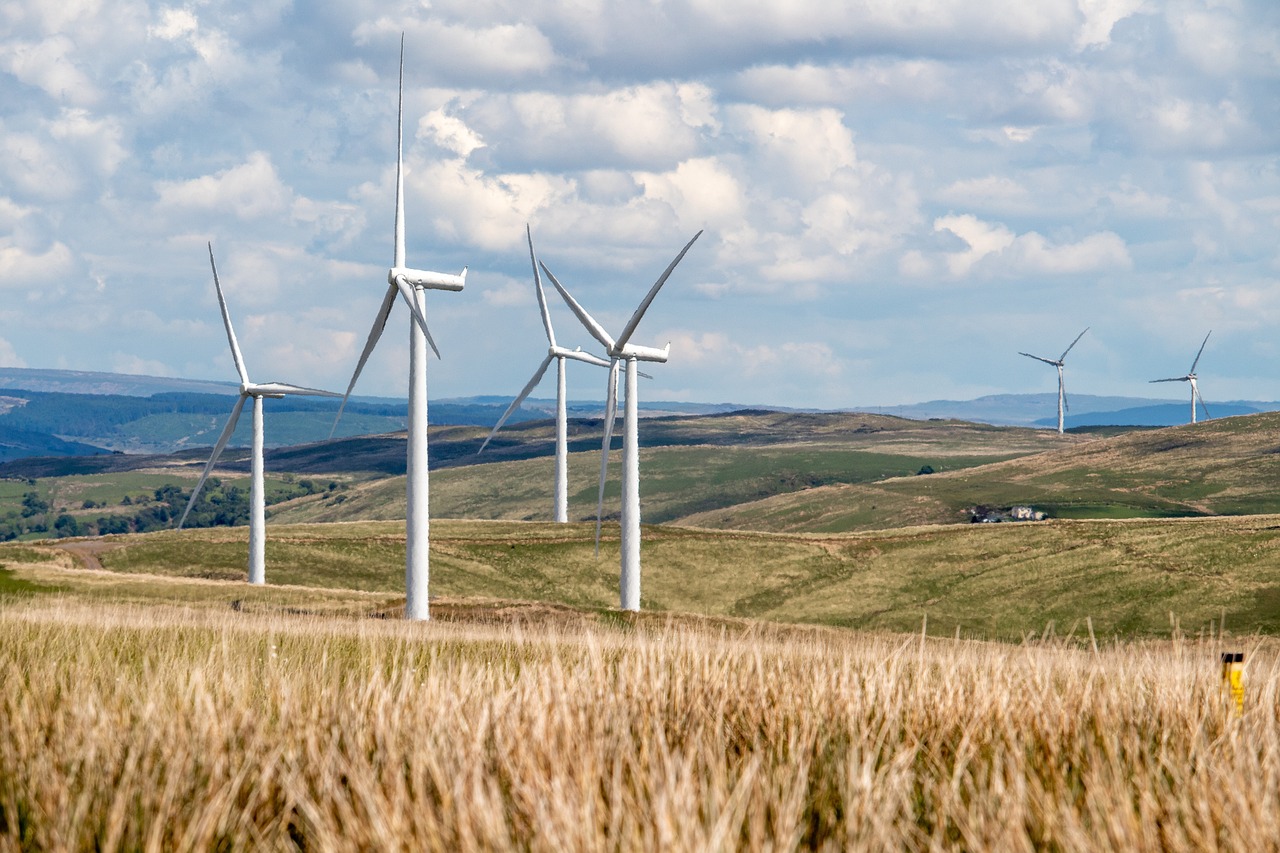As the world increasingly recognizes the importance of environmental sustainability, the demand for green investment opportunities continues to rise. Businesses and individuals alike are seeking ways to align their financial goals with their desire to make a positive impact on the planet. In this article, we will explore the various green investment opportunities available in today’s market. From renewable energy projects to sustainable agriculture, we will delve into the possibilities that can not only generate financial returns but also contribute to a greener future. Join us as we explore this growing field and discover how you can invest in a more sustainable world.

Types of Green Investments
Green investments refer to financial investments that focus on supporting and promoting environmentally friendly initiatives. These investments aim to generate both sustainable and profitable outcomes, ensuring that businesses and individuals can contribute to a cleaner and greener future. There are several types of green investments available, each with its own unique benefits and potential for growth. Let’s explore some of the most popular types of green investments:
Renewable Energy Projects
Investing in renewable energy projects is a powerful way to combat climate change and reduce reliance on fossil fuels. Renewable energy sources, such as solar power, wind energy, hydroelectric power, geothermal energy, and bioenergy, offer a sustainable and clean alternative to traditional energy sources. These projects provide opportunities for investors to support the development and expansion of renewable energy infrastructure while earning attractive financial returns.
Energy Efficiency Initiatives
Energy efficiency initiatives focus on reducing energy consumption and waste. By investing in energy-efficient technologies, building retrofits, smart grid technology, and energy storage, businesses can significantly lower their energy costs and carbon footprint. Energy efficiency investments not only help mitigate climate change but also contribute to long-term cost savings and improved competitiveness for businesses.
Sustainable Agriculture
Sustainable agriculture investments involve supporting farming practices that prioritize environmental sustainability and biodiversity. Organic farming, agroforestry, aquaponics, vertical farming, and precision agriculture all fall under the umbrella of sustainable agriculture. These investments aim to promote sustainable food production while minimizing the use of harmful chemicals and protecting natural resources. Investing in sustainable agriculture can provide a stable and profitable return while positively impacting the environment.
Green Real Estate
Green real estate investments focus on properties that are designed and built with sustainability in mind. These investments include green building certifications, energy-efficient retrofitting, green roofing, smart home technologies, and sustainable communities. By investing in green real estate, businesses can reduce their environmental impact, lower operating costs, and attract environmentally conscious tenants or buyers.
Clean Transportation
Clean transportation investments involve supporting modes of transportation that have lower or zero carbon emissions. Electric vehicles, biofuels, public transportation, cycling infrastructure, and car-share programs all contribute to a cleaner and more sustainable transportation sector. Investing in clean transportation not only helps combat air pollution and minimize reliance on fossil fuels but also supports the development and adoption of innovative transportation solutions.
Green investments offer a wide range of opportunities for businesses and individuals to make a positive impact on the environment while also generating financial returns. By diversifying their investment portfolios and incorporating green investments, companies can align their values with their financial goals.
Benefits of Green Investments
Investing in environmentally friendly initiatives provides a myriad of benefits, beyond just supporting a sustainable future. Let’s delve into some of the key benefits that green investments offer:
Environmental Impact
One of the most significant benefits of green investments is the positive environmental impact they create. By investing in renewable energy projects, energy efficiency initiatives, sustainable agriculture, green real estate, and clean transportation, businesses and individuals contribute to reducing greenhouse gas emissions, conserving natural resources, and preserving ecosystems. These investments play a crucial role in combating climate change and promoting a cleaner and healthier planet for future generations.
Financial Returns
Contrary to the common misconception that green investments offer lower financial returns, many green investment opportunities can be highly profitable. Renewable energy projects, for example, have demonstrated strong financial performance over the years, offering competitive returns for investors. Energy efficiency initiatives not only provide cost savings through reduced energy consumption but also enhance the value and marketability of properties. Additionally, the growing demand for sustainable products and services presents investment opportunities with substantial growth potential.
Long-Term Stability
Green investments often provide long-term stability in terms of both financial returns and market demand. As environmental issues and climate change become increasingly prominent, the demand for sustainable solutions and products grows. This sustained demand ensures the stability and continuous growth of green investment sectors. Furthermore, investing in green initiatives can also help businesses mitigate risks associated with rising energy costs, regulatory changes, and potential liabilities.
By investing in green projects, businesses can reap the benefits of both financial success and environmental responsibility. These investments provide a unique opportunity to align financial interests with ethical values, creating a win-win situation for investors and the planet.
Investing in Renewable Energy Projects
Renewable energy projects play a vital role in transitioning to a clean and sustainable energy future. By investing in these projects, businesses can support the development and expansion of renewable energy infrastructure while enjoying attractive financial returns. Let’s explore some of the key renewable energy options available for investment:
Solar Power
Solar power is one of the most abundant and widely accessible renewable energy sources on Earth. By harnessing the power of sunlight, solar panels convert sunlight into electricity, providing a clean and reliable source of energy. Investing in solar power projects, such as solar farms or rooftop solar installations, offers attractive returns while significantly reducing carbon emissions.
Wind Energy
Wind energy harnesses the power of the wind to generate electricity. Wind turbines, typically located in wind farms or offshore, capture the kinetic energy of the wind and convert it into usable electricity. Investing in wind energy projects provides an opportunity to support clean energy generation and capitalize on the rapidly growing wind power industry.
Hydroelectric Power
Hydroelectric power utilizes the energy of flowing or falling water to generate electricity. By constructing dams or utilizing existing waterways, hydroelectric power plants convert the energy of water into electrical energy. Investing in hydroelectric projects can offer stable and long-term returns, as water is a reliable and renewable source of energy.
Geothermal Energy
Geothermal energy harnesses the heat stored within the Earth’s crust to generate electricity or heat buildings. By tapping into deep underground reservoirs of hot water or steam, geothermal power plants produce clean and renewable energy. Investing in geothermal energy projects can provide reliable returns, as geothermal resources are accessible year-round and not dependent on weather conditions.
Bioenergy
Bioenergy refers to the use of organic materials, such as agricultural waste, wood pellets, or dedicated energy crops, to generate heat, electricity, or biofuels. By investing in bioenergy projects, businesses can contribute to reducing waste and utilizing renewable resources. Bioenergy investments often provide a reliable and scalable source of energy.
Investing in renewable energy projects offers a unique opportunity to support clean energy generation, reduce carbon emissions, and enjoy competitive financial returns. These investments not only help combat climate change but also contribute to a more sustainable and resilient energy system.
Energy Efficiency Initiatives
Energy efficiency initiatives play a crucial role in reducing energy consumption, cutting costs, and minimizing environmental impact. By investing in energy-efficient technologies and practices, businesses can optimize their energy usage, lower operational expenses, and contribute to a greener future. Let’s explore some key energy efficiency initiatives worth considering:
Energy-Efficient Technologies
Investing in energy-efficient technologies, such as LED lighting, energy-efficient appliances, and HVAC systems, can significantly reduce energy consumption and operating costs. These technologies are designed to maximize energy efficiency while maintaining or even improving performance. By incorporating energy-efficient technologies into their operations, businesses can enjoy long-term savings and enhance their environmental credentials.
Building Retrofits
Building retrofits involve upgrading existing buildings to improve energy efficiency. By enhancing insulation, replacing outdated equipment, and optimizing heating and cooling systems, businesses can reduce energy waste and lower utility expenses. Building retrofits not only enhance energy efficiency but also enhance occupant comfort and productivity.
Smart Grid Technology
Smart grid technology refers to the integration of digital communication and automation into the electrical grid. By deploying sensors, smart meters, and advanced analytics, businesses can optimize energy usage, manage peak demand, and reduce reliance on fossil fuels. Smart grid technology enables grid operators to balance energy supply and demand more effectively, leading to a more efficient and resilient energy infrastructure.
Energy Storage
Energy storage solutions, such as batteries and flywheels, play a crucial role in maximizing the benefits of renewable energy sources. By storing excess energy generated by renewable sources, businesses can tap into this stored energy during times of high demand or when renewable sources are unavailable. Energy storage investments ensure a reliable and continuous supply of clean energy.
Investing in energy efficiency initiatives not only helps businesses reduce their environmental impact but also provides long-term financial benefits. By optimizing energy usage and lowering utility expenses, businesses can enhance their competitiveness and improve their bottom line.
Sustainable Agriculture Investments
Sustainable agriculture investments focus on supporting farming practices that prioritize environmental sustainability, conservation of natural resources, and biodiversity. By investing in sustainable agriculture, businesses can contribute to sustainable food production while minimizing the use of harmful chemicals and preserving ecosystems. Here are some key sustainable agriculture investment opportunities:
Organic Farming
Organic farming involves cultivating crops or raising livestock without the use of synthetic fertilizers, pesticides, genetically modified organisms (GMOs), or growth hormones. By investing in organic farming, businesses support sustainable farming practices that promote soil health, biodiversity, and natural resource conservation. Organic products also command premium prices in the market, offering attractive returns for investors.
Agroforestry
Agroforestry involves the integration of trees and crops or livestock in a mutually beneficial manner. By incorporating trees into agricultural landscapes, businesses can enhance soil fertility, reduce erosion, provide shade, and diversify income streams. Agroforestry investments offer a sustainable and resilient approach to farming while supporting biodiversity and carbon sequestration.
Aquaponics
Aquaponics is a sustainable farming method that combines aquaculture (fish farming) and hydroponics (growing plants in water). By utilizing the waste produced by fish to fertilize plants and the plants to filter and clean the water for the fish, aquaponics systems create a symbiotic relationship that requires minimal water and no chemical fertilizers. Investing in aquaponics supports efficient and sustainable food production in water-limited environments.
Vertical Farming
Vertical farming involves growing crops indoors in vertically stacked layers. By utilizing vertical space and employing controlled environments with artificial lighting and climate control, vertical farming maximizes food production in urban areas and reduces the need for large land areas. Investing in vertical farming supports localized and sustainable food production, reduces transportation emissions, and helps feed growing urban populations.
Precision Agriculture
Precision agriculture utilizes technology and data analysis to optimize crop production and reduce waste. By employing techniques like remote sensing, geographic information systems (GIS), and real-time data monitoring, precision agriculture enables farmers to make informed decisions about crop inputs, irrigation, and pest management. Investing in precision agriculture supports efficient and sustainable farming practices while minimizing the environmental impact.
Sustainable agriculture investments offer a unique opportunity to support resilient food systems, protect natural resources, and promote biodiversity. By incorporating sustainable farming practices, businesses contribute to a more sustainable and secure food supply while capitalizing on the growing demand for organic and sustainably produced food.
Green Real Estate Investment Opportunities
Green real estate investments focus on properties that are designed and built with sustainability in mind. These investments offer opportunities for businesses to reduce their environmental impact, lower operating costs, and attract environmentally conscious tenants or buyers. Here are some key green real estate investment opportunities:
Green Building Certifications
Green building certifications, such as LEED (Leadership in Energy and Environmental Design) or BREEAM (Building Research Establishment Environmental Assessment Method), indicate that a building meets specific sustainability criteria. Investing in green building certified properties ensures that the building has been designed and constructed using environmentally friendly practices, energy-efficient systems, and sustainable materials.
Energy-Efficient Retrofitting
Energy-efficient retrofitting involves upgrading existing buildings to improve energy performance. By enhancing insulation, replacing windows, optimizing heating and cooling systems, and incorporating energy-efficient lighting, businesses can significantly reduce energy consumption and operating costs. Energy-efficient retrofits not only lead to cost savings but also enhance the marketability and value of the property.
Green Roofing
Green roofing involves the installation of vegetation or green spaces on the roofs of buildings. Green roofs provide numerous environmental benefits, including reduced stormwater runoff, improved air quality, and enhanced thermal insulation. Investing in green roofing supports sustainable urban development, reduces the urban heat island effect, and contributes to biodiversity preservation.
Smart Home Technologies
Smart home technologies enable the integration and automation of various systems within a building, such as lighting, heating, ventilation, and security. By utilizing sensors, connectivity, and real-time data analysis, smart home technologies optimize energy usage, enhance comfort, and improve efficiency. Investing in properties with smart home technologies provides a unique selling point and enhances the overall sustainability of the building.
Sustainable Communities
Investing in sustainable communities involves supporting the development of environmentally friendly neighborhoods and urban areas. These communities prioritize features such as walkability, access to public transit, green spaces, and energy-efficient infrastructure. Sustainable communities promote a healthier and more sustainable lifestyle while reducing the reliance on privately owned vehicles and minimizing carbon emissions.
Green real estate investments offer businesses an opportunity to reduce their environmental footprint, improve operational efficiency, and attract eco-conscious tenants or buyers. By incorporating sustainable design, energy-efficient systems, and innovative technologies, businesses can unlock the financial and environmental benefits of green real estate.

Clean Transportation Investments
Clean transportation investments focus on supporting modes of transportation that have lower or zero carbon emissions. By investing in clean transportation initiatives, businesses can contribute to reducing air pollution, minimizing reliance on fossil fuels, and promoting sustainable mobility. Here are some key clean transportation investment opportunities:
Electric Vehicles
Electric vehicles (EVs) are vehicles powered by electricity stored in rechargeable batteries. By investing in electric vehicles and supporting the development of charging infrastructure, businesses can accelerate the adoption of clean and efficient transportation. Electric vehicles offer numerous advantages, including reduced air pollution, lower operating costs, and increased energy independence.
Biofuels
Biofuels are fuels derived from renewable sources, such as crops, agricultural waste, or algae. By investing in biofuels and supporting their production and distribution, businesses can help reduce greenhouse gas emissions associated with traditional fossil fuels. Biofuels can be used in existing vehicles and infrastructure without significant modifications, making them a viable and sustainable alternative to fossil fuels.
Public Transportation
Investing in public transportation systems, such as buses, trams, or trains, promotes efficient and sustainable mobility. By supporting the development of reliable and accessible public transportation networks, businesses can reduce traffic congestion, air pollution, and carbon emissions. Public transportation investments also contribute to creating more livable and connected communities.
Cycling Infrastructure
Investing in cycling infrastructure, such as dedicated bike lanes, bike-sharing programs, and secure bicycle parking, promotes active transportation and reduces reliance on cars. By creating safe and convenient cycling options, businesses can encourage employees and community members to choose sustainable modes of transportation. Cycling infrastructure investments improve public health, reduce traffic congestion, and enhance overall mobility.
Car-Share Programs
Car-share programs provide individuals and businesses with access to shared vehicles for short periods, eliminating the need for private car ownership. By investing in car-share programs or partnering with existing providers, businesses can promote resource-efficient urban transportation and reduce the number of cars on the road. Car-share programs contribute to reducing parking demand, traffic congestion, and greenhouse gas emissions.
Clean transportation investments offer businesses a unique opportunity to support sustainable mobility and reduce their carbon footprint. By investing in electric vehicles, biofuels, public transportation, cycling infrastructure, and car-share programs, businesses can contribute to a greener and more connected transportation system.
Risks of Green Investments
While green investments offer numerous benefits, like any investment, they come with their fair share of risks. Understanding and managing these risks is crucial for making informed investment decisions. Here are some key risks associated with green investments:
Long Payback Periods
Some green investments, such as renewable energy projects or energy efficiency initiatives, may have longer payback periods compared to traditional investments. The time required to recoup the initial investment can be influenced by factors like technological advancements, changing market conditions, and policy support. Investors need to carefully assess the potential payback period and consider their own risk appetite before investing in green projects.
Regulatory Uncertainty
Green investments are subject to regulatory frameworks and policies that can impact their financial viability. Changes in regulations, government incentives, or subsidy programs can significantly affect the profitability and attractiveness of green investments. Investors need to stay informed about evolving regulations related to green initiatives and assess the potential impact on their investments.
Changing Government Policies
Government policies play a crucial role in supporting and promoting green investments. However, policies can change over time due to political shifts, economic considerations, or changing priorities. Changes in government policies, such as modifications in renewable energy support schemes or carbon pricing mechanisms, can affect the financial returns and market dynamics of green investments.
Technological Advances
The rapid pace of technological advancements in the green sector can pose both risks and opportunities for investors. Emerging technologies or breakthrough innovations can disrupt existing markets, impact the competitiveness of certain investments, and create uncertainty. Investors need to carefully assess the technological landscape and consider the potential risks associated with investing in specific green technologies.
Market Volatility
Like any investment, green investments are subject to market volatility and fluctuations. Market dynamics, supply and demand imbalances, or changes in investor sentiment can influence the financial performance of green investments. Investors need to carefully evaluate market conditions, diversify their portfolios, and consider their long-term investment objectives when investing in green initiatives.

How to Choose the Right Green Investments
Choosing the right green investments requires careful consideration and evaluation. Here are some key steps to help you make informed investment decisions:
Define Your Investment Goals
Start by defining your investment goals and objectives. Are you looking for long-term financial returns, environmental impact, or a combination of both? Clarifying your investment goals will help you narrow down your options and align your investments with your values and priorities.
Assess the Risk-Reward Ratio
Evaluate the risk-reward ratio of potential green investments. Consider factors such as potential financial returns, payback periods, regulatory risks, and market dynamics. A thorough analysis of the risk-reward profile will help you gauge the feasibility and suitability of different investment opportunities.
Research the Market
Conduct comprehensive market research to identify emerging trends, new technologies, and investment opportunities. Stay abreast of market developments, policy changes, and industry dynamics. Understanding the market landscape will enable you to make informed investment decisions and capitalize on potential growth areas.
Consider Diversification
Diversify your green investment portfolio to spread risks and maximize potential returns. Invest in a mix of different green initiatives, technologies, and sectors. Diversification helps mitigate the impact of individual investment risks and allows you to benefit from multiple market opportunities.
Seek Professional Advice
Consider consulting with financial advisors or green investment experts. They can provide valuable insights, expertise, and guidance tailored to your investment goals and risk tolerance. Professional advice can help you make well-informed decisions and navigate the complexities of the green investment landscape.
By following these steps and conducting thorough due diligence, you can choose the right green investments that align with your financial objectives and sustainability goals.
Frequently Asked Questions
What are the tax advantages of green investments?
Green investments may offer tax advantages depending on the jurisdiction and specific investment opportunities. Tax incentives and credits, such as renewable energy tax credits or energy efficiency deductions, are often available to promote and incentivize green investments. It is recommended to consult with tax professionals or financial advisors to understand the specific tax advantages applicable to different green investment options.
Can I invest in green energy companies on the stock market?
Yes, many green energy companies are publicly traded and can be invested in through the stock market. Investing in green energy companies on the stock market provides an opportunity to support the growth and development of the clean energy sector while potentially earning financial returns. However, it is essential to conduct thorough research, assess the company’s fundamentals, and consider the potential risks before investing in any publicly traded company.
Are green investments suitable for individuals or only businesses?
Green investments are suitable for both individuals and businesses. While businesses can invest in green initiatives to align with their sustainability goals and enhance their corporate social responsibility, individuals can also invest in green projects to support clean energy, sustainable agriculture, or other environmentally friendly initiatives. Green investments can be accessible to investors of various sizes and types.
How can I ensure that my green investments align with my values?
To ensure that your green investments align with your values, conduct thorough research on the investment opportunities, their environmental impact, and any sustainability certifications or standards they adhere to. Consider investing in projects or companies that share a similar vision and commitment to sustainability. Furthermore, seeking advice from green investment experts or consulting platforms that specialize in sustainable investments can help you make informed decisions that resonate with your values.
What is the potential for growth in the green investment sector?
The green investment sector has significant growth potential as the world transitions to a more sustainable and low-carbon economy. The increasing awareness of climate change, environmental degradation, and resource limitations drive the demand for green investments. As governments, businesses, and individuals adopt more sustainable practices, the demand for renewable energy, energy efficiency initiatives, sustainable agriculture, green real estate, and clean transportation will continue to grow. The green investment sector presents a unique opportunity for investors to support positive change while pursuing financial returns.
Note: This comprehensive article provides an overview of various types of green investments, their benefits, risks, and insights into how to choose the right green investments. It aims to educate readers about the potential opportunities and considerations associated with green investments. However, it is essential to conduct further research and seek professional advice before making any investment decisions.













